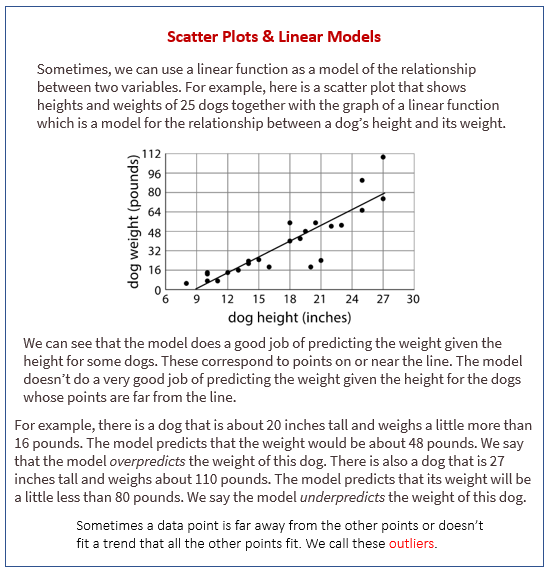Illustrative Mathematics Grade 8, Unit 6, Lesson 4: Fitting a Line to Data
Learning Targets:
- I can pick out outliers on a scatter plot.
- I can use a model to predict values for data.
Related Pages
Illustrative Math
Grade 8
Lesson 4: Fitting a Line to Data
Let’s look at the scatter plots as a whole.
Illustrative Math Unit 8.6, Lesson 4 (printable worksheets)
Lesson 4 Summary
The following diagram shows how to use a linear model to predict values for data on a scatter plot.

Lesson 4.1 Predict This
Here is a scatter plot that shows weights and fuel efficiencies of 20 different types of cars.
If a car weighs 1,750 kg, would you expect its fuel efficiency to be closer to 22 mpg or to 28 mpg? Explain your reasoning.
Lesson 4.2 Shine Bright
The prices and sizes of 20 different diamonds are shown in the table and scatter plot.
The scatter plot shows the prices and weights of the 20 diamonds together with the graph of y = 5,520x - 1,091.
Open Applet
The function described by the equation y =5,520x - 1,091 is a model of the relationship between a diamond’s weight and its price.
This model predicts the price of a diamond from its weight. These predicted prices are shown in the third column of the table.
- Two diamonds with a weight of 1.5 carats have different prices. What are their prices? How can you see this in the table? How can you see this in the graph?
- The model predicts that when the weight is 1.5 carats, the price will be $7,189. How can you see this in the graph? How can you see this using the equation?
- One of the diamonds weighs 1.9 carats. What does the model predict for its price? How does that compare to the actual price?
- Find a diamond where the model makes a very good prediction of the actual price. How can you see this in the table? In the graph?
- Find a diamond where the model’s prediction is not very close to the actual price. How can you see this in the table? In the graph?
Lesson 4.3 The Agony of the Feet
The scatter plot shows widths and lengths of 20 different left feet. Use the double arrows to show or hide the expressions list.
Open Applet
- Estimate the widths of the longest foot and the shortest foot.
- Estimate the lengths of the widest foot and the narrowest foot.
- Click on the gray circle next to the words “The Line” in the expressions list.
The graph of a linear model should appear. Find the data point that seems weird when compared to the model. What length and width does that point represent?
Lesson 4 Practice Problems
- The scatter plot shows the number of hits and home runs for 20 baseball players who had at least 10 hits last season. The table shows the values for 15 of those players.
The model, represented by y = 0.15x - 1.5, is graphed with a scatter plot.
Use the graph and the table to answer the questions.
a. Player A had 154 hits in 2015. How many home runs did he have? How many was he predicted to have?
b. Player B was the player who most outperformed the prediction. How many hits did Player B have last season?
c. What would you expect to see in the graph for a player who hit many fewer home runs than the model predicted? - Here is a scatter plot that compares points per game to free throw attempts per game for basketball players in a tournament. The model, represented by y = 4.413x + 0.377, is graphed with the scatter plot. Here, x represents free throw attempts per game, and represents points per game.
a. Circle any data points that appear to be outliers.
b. What does it mean for a point to be far above the line in this situation?
c. Based on the model, how many points per game would you expect a player who attempts 4.5 free throws per game to have? Round your answer to the nearest tenth of a point per game.
d. One of the players scored 13.7 points per game with 4.1 free throw attempts per game. How does this compare to what the model predicts for this player?
The Open Up Resources math curriculum is free to download from the Open Up Resources website and is also available from Illustrative Mathematics.
Try out our new and fun Fraction Concoction Game.
Add and subtract fractions to make exciting fraction concoctions following a recipe. There are four levels of difficulty: Easy, medium, hard and insane. Practice the basics of fraction addition and subtraction or challenge yourself with the insane level.

We welcome your feedback, comments and questions about this site or page. Please submit your feedback or enquiries via our Feedback page.